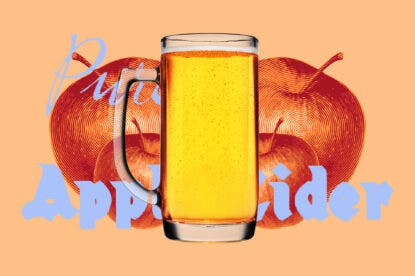We all know the world of wine is ever expanding. The average wine drinker is now exposed to more varieties, regions and styles than ever before. Those who choose to push their tasting boundaries can look beyond the retail shelves flooded with Pinot Grigio and Cabernet Sauvignon and instead enjoy the discovery of a minerally Etna Bianco or a spicy Austrian Zweigelt.
However, many beverage connoisseurs have yet to catch on to an under-sung sector of wine: cider. That’s right, cider is technically a wine.
Six-pack cases and countless kegs of sweet, apple-y, alcoholic juice have visually put cider in the same beverage camp as beer. To boot, the Alcohol and Tobacco Tax and Trade Bureau (TTB) has segregated the category, deeming anything made with apples and under 8.5% alcohol by volume (abv) cider (or more commonly, hard cider) and anything above that limit fruit wine, thereby bringing into question the beverage’s true alliances.
Cider’s fermentation path is technically akin to grape wine production, and the whole category deserves to be treated as such.
But the real truth about cider could not be more clear. Its fermentation path is technically akin to grape wine production—juice plus yeast equals alcohol and carbon dioxide—and the whole category deserves to be treated as such.
Much like grape wine, variety selection is important in cider. Similar to how table or juice grapes are not ideal for winemaking, common eating apples—think Fuji, Gala, Pink Lady—are not the best options for making the most complex or balanced cider. High-tannin and/or high-acid fruit is key for quality production. Most of the varieties are obscure, rock hard and solely cultivated for use in cider.
While there are examples of single-variety ciders, many of the best bottlings are made from a blend of apples that each lend different flavor and structural components, the same way a well balanced Bordeaux meshes the juicy roundness of Merlot with the structure and intensity of Cabernet. It’s quite common for apple varieties to play a minor role on a cider label, just as Old World wine labels often highlight the terroir of the region as opposed to the grapes inside.
The cider category as a whole is quite diverse, encompassing everything from hop- or fruit-inflected options made from apple concentrate to pours that truly express time and place in the bottle. Though mass-appeal ciders currently dominate the market, it’s the small-batch, thoughtful producers that deserve the most attention. Unfortunately, most consumers barely know they exist.
Great ciders are already here, and as more and more people become familiar with the category, the bar for quality will surely rise across the board. So the next time you’re in a wine shop, give more attention to the cider section and be a part of this burgeoning category.
A mixed six ciders to try
Art & Science 2016 Humble Cider (Oregon); Wine and cider are hand in hand from this producer that dabbles in both grape and apple wine.
Barrika Basque Cider (Spain); Bright and vibrant—think Txakoli (from the same region) but made with apples.
Oliver’s Traditional Cider (England); A classic Herefordshire cider that blends rich orchard fruit with a lot of grip.
Redbyrd 2017 Cloudsplitter (New York); A traditional method cider made from biodynamically grown apples from the Finger Lakes.
Tilted Shed 2017 Lost Orchard (California); Organically grown fruit from Sonoma yields an earthy, tannic cider.
Weidmann & Groh Grohsecco (Germany); If you’re into Prosecco, check out this German alternative.
Published: September 18, 2019















